Mechanical Properties and Microstructure of W-6Ni-4Co Alloy by a Two-Step Sintering Process
Abstract
:1. Introduction
2. Experimental Procedure
3. Results and Discussion
3.1. Characterization of W-6Ni-4Co Alloy Milled Powders
3.2. Relative Density of W-6Ni-4Co Alloys
3.3. Microstructure Evolution of W-6Ni-4Co Alloy
3.4. Mechanical Properties of W-6Ni-4Co Alloy
3.5. Fracture Morphology of W-6Ni-4Co Alloy
4. Conclusions
- (1)
- The particle size of W-6Ni-4Co alloy milled powders increased firstly due to sheet and agglomeration of particles and decreased later for fracture of particles during a mechanical alloying process.
- (2)
- The shapes of W-rich particles changed from stripes to network, to polygonal and to subsphaeroidal finally, and the best compact structure formed at sintering temperature of 1450 °C and dwelling time of 60 min.
- (3)
- The samples were characterized by excellent comprehensive property during two-step sintering with short dwelling time of 5 min. The best results of microhardness, compressive strength, flexural strength, yield strength and compressive toughness are 596.5 HV, 2483 MPa and 1850 MPa, 1437 MPa and 625 J·cm−3 respectively. The mechanical properties can be attributed to the synergistic effect of densification, grain refining and distribution of the W-rich phase and binder phase.
Author Contributions
Funding
Acknowledgments
Conflicts of Interest
References
- Sengupta, P.; Debata, M. Effect of partial and full substitution of Ni with NiB on densification, structure and properties of 90W-6Ni-2Fe-2Co heavy alloys. J. Alloys Compd. 2019, 774, 145–152. [Google Scholar] [CrossRef]
- Zhuo, L.; Zhang, Y.; Zhao, Z.; Luo, B.; Chen, Q.; Liang, S. Preparation and properties of ultrafine-grained W-Cu composites reinforced with tungsten fibers. Mater. Lett. 2019, 243, 26–29. [Google Scholar] [CrossRef]
- Hu, K.; Wang, G.H.; Li, X.Q.; Qu, S.G. Microstructure and formation mechanism in a surface carburized tungsten heavy alloy. J. Alloys Compd. 2019, 787, 560–569. [Google Scholar] [CrossRef]
- Gu, D.; Li, Y.; Wang, H.; Jia, Q.; Zhang, G. Microstructural development and its mechanism of mechanical alloyed nanocrystalline W-10Ni alloy reinforced with Y2O3 nanoparticles. Int. J. Refract. Met. Hard Mater. 2014, 44, 113–122. [Google Scholar] [CrossRef]
- Ding, L.; Xiang, D.; Pan, Y.; Li, Y. Mechanical properties and microstructural evolution of Mo-Co-co-strengthened W-Ni-Fe alloys by spark plasma sintering. J. Alloys Compd. 2017, 712, 593–598. [Google Scholar] [CrossRef]
- Patra, A.; Meraj, M.; Pal, S.; Yedla, N.; Karak, S.K. Experimental and atomistic simulation based study of W based alloys synthesized by mechanical alloying. Int. J. Refract. Met. Hard Mater. 2014, 58, 57–67. [Google Scholar] [CrossRef]
- Patra, A.; Sahoo, R.R.; Karak, S.K.; Sahoo, S.K. Effect of nano Y2O3 dispersion on thermal, microstructure, mechanical and high temperature oxidation behavior of mechanically alloyed W-Ni-Mo-Ti. Int. J. Refract. Met. Hard Mater. 2018, 70, 134–154. [Google Scholar] [CrossRef]
- Kilic, M.; Ozyurek, D.; Tuncay, T. Dry Sliding wear behavior and microstructure of the W-Ni-Fe and W-Ni-Cu heavy alloys produced by powder metallurgy technique. Powder. Metall. Met. C 2016, 55, 73–84. [Google Scholar] [CrossRef]
- Chen, C.; Ma, S.H. Study on characteristics and sintering behavior of W-Ni-Co tungsten heavy alloy by a secondary ball milling method. J. Alloys Compd. 2018, 731, 78–83. [Google Scholar] [CrossRef]
- Saxena, R.; Patra, A.; Karak, S.K.; Ciupinski, L. Fabrication and characterization of nano-Y2O3 dispersed W-Ni-Nb alloys. Int. J. Refract. Met. Hard Mater. 2018, 71, 70–78. [Google Scholar] [CrossRef]
- Patra, A.; Saxena, R.; Karak, S.K.; Laha, T.; Sahoo, S.K. Fabrication and characterization of nano-Y2O3 dispersed W-Ni-Mo and W-Ni-Ti-Nb alloys by mechanical alloying and spark plasma sintering. J. Alloys Compd. 2017, 707, 245–250. [Google Scholar] [CrossRef]
- Pan, Y.; Ding, L.; Xiang, D. Microstructure evolution and mechanical properties of spark plasma sintered W-Ni-Mn alloy. Trans. Nonferrous Met. Soc. Chin. 2017, 27, 1588–1593. [Google Scholar] [CrossRef]
- Chen, Y.; Wu, Y.; Yu, F.; Chen, J. Microstructure and mechanical properties of tungsten composites co-strengthened by dispersed TiC and La2O3 particles. Int. J. Refract. Met. Hard Mater. 2008, 26, 525–529. [Google Scholar] [CrossRef]
- Kim, Y.; Lee, S.; Kim, E.P.; Noh, J.W. Effects of ThO2 on the solid) state sintering behavior of W-Ni-Fe alloy. Int. J. Refract. Met. Hard Mater. 2011, 29, 112–116. [Google Scholar] [CrossRef]
- Cui, K.; Shen, Y.; Yu, J.; Ji, B. Microstructural characteristics of commercial purity W and W-1% La2O3 alloy. Int. J. Refract. Met. Hard Mater. 2013, 41, 143–151. [Google Scholar] [CrossRef]
- Li, W.; Dong, H. Effect of nano-Y2O3 on microstructure and mechanical properties of W-Ni-Cu alloys. Mater. Res. Express 2018, 5, 106503. [Google Scholar] [CrossRef]
- Chen, C.; Ma, S.H. Study on combination of in-situ dispersion and secondary ball milling for W-Ni-Co tungsten heavy alloy. Int. J. Refract. Met. Hard Mater. 2018, 71, 8–14. [Google Scholar] [CrossRef]
- Chen, C.; Ma, S.H. Effects of Ni/Co ratio and mechanical alloying on characteristics and sintering behavior of W-Ni-Co tungsten heavy alloys. J. Alloys Compd. 2017, 711, 488–494. [Google Scholar] [CrossRef]
- Hamidi, A.G.; Arabi, H.; Khaki, J.V. Sintering of a nano-crystalline tungsten heavy alloy powder. Int. J. Refract. Met. Hard Mater. 2019, 80, 204–209. [Google Scholar] [CrossRef]
- Shi, K.; Huang, B.; He, B.; Xiao, Y.; Yang, X.; Lian, Y.; Liu, X.; Tang, J. Room-temperature tensile strength and thermal shock behavior of spark plasma sintered W-K-TiC alloys. Nucl. Eng. Technol. 2019, 51, 190–197. [Google Scholar] [CrossRef]
- Dinçer, O.; Pehlivanoğlu, M.K.; Çalişkan, N.K.; Karakaya, İ.; Kalkanli, A. Processing and microstructural characterization of liquid phase sintered tungsten–nickel–cobalt heavy alloys. Int. J. Refract. Met. Hard Mater. 2015, 50, 106–112. [Google Scholar] [CrossRef]
- Jung, W.K.; Ma, H.J.; Kim, D.G.; Kim, D.K. Two-step sintering behavior of titanium-doped Y2O3 ceramics with monodispersed sub) micrometer powder. Ceram. Int. 2019, 45, 510–515. [Google Scholar] [CrossRef]
- Fan, Z.S.; Xiang, D.P.; Pan, Y.L.; Jiang, H. Effect of two-time spark plasma sintering on microstructure and mechanical properties of W-6Ni-4Mn alloy. Mater. Sci. Eng. A 2019, 745, 300–306. [Google Scholar] [CrossRef]
- Sato, J.; Omori, T.; Oikawa, K.; Ohnuma, I.; Kainuma, R.; Ishida, K. Co-based high-temperature alloys. Science 2006, 312, 90–91. [Google Scholar] [CrossRef] [PubMed]
- Nagasaki, S.; Hirabayashi, M. Binary Alloy Phase-Diagrams; AGNE Gijutsu Center, Co., Ltd.: Tokyo, Japan, 2002. [Google Scholar]
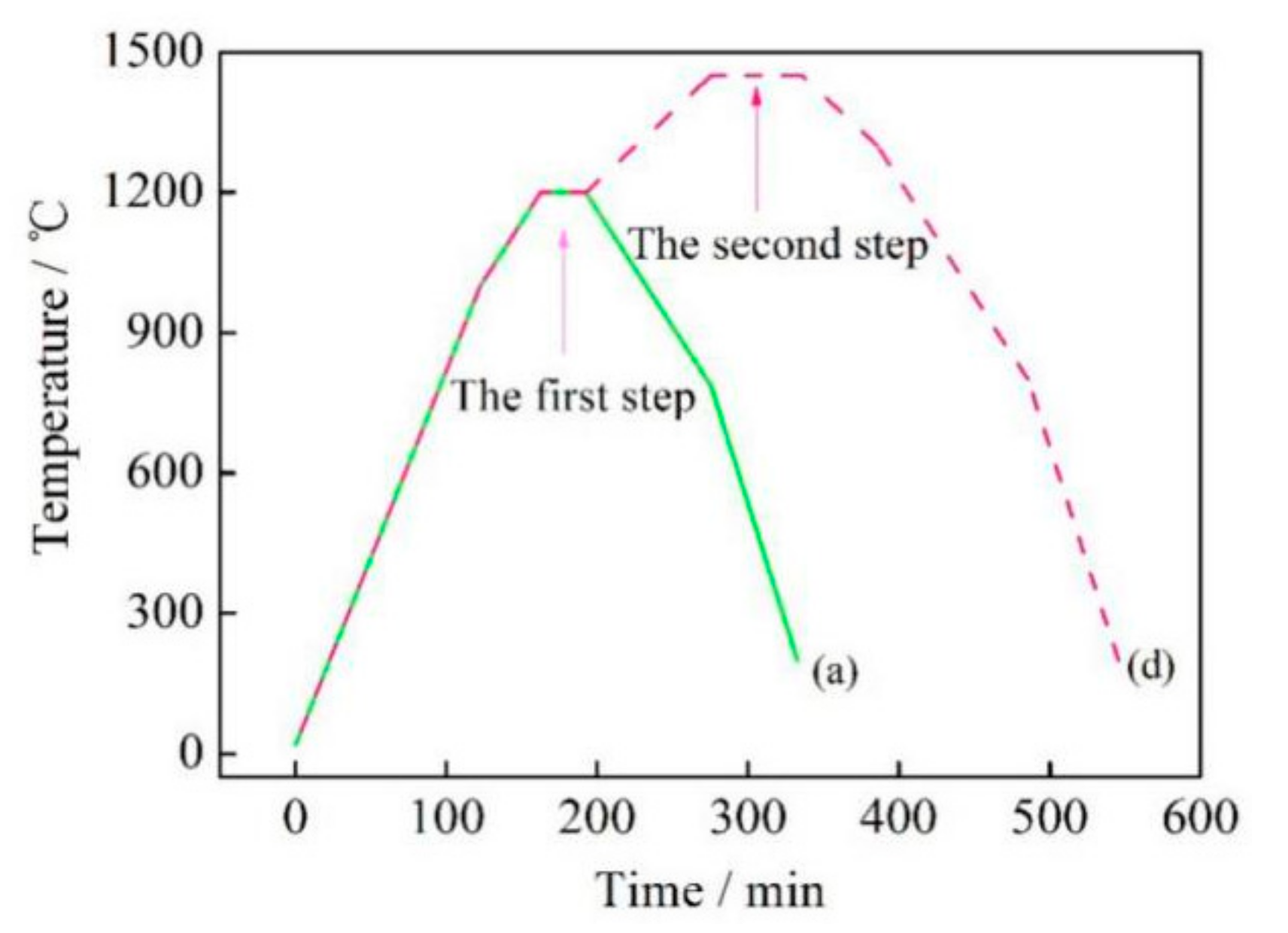

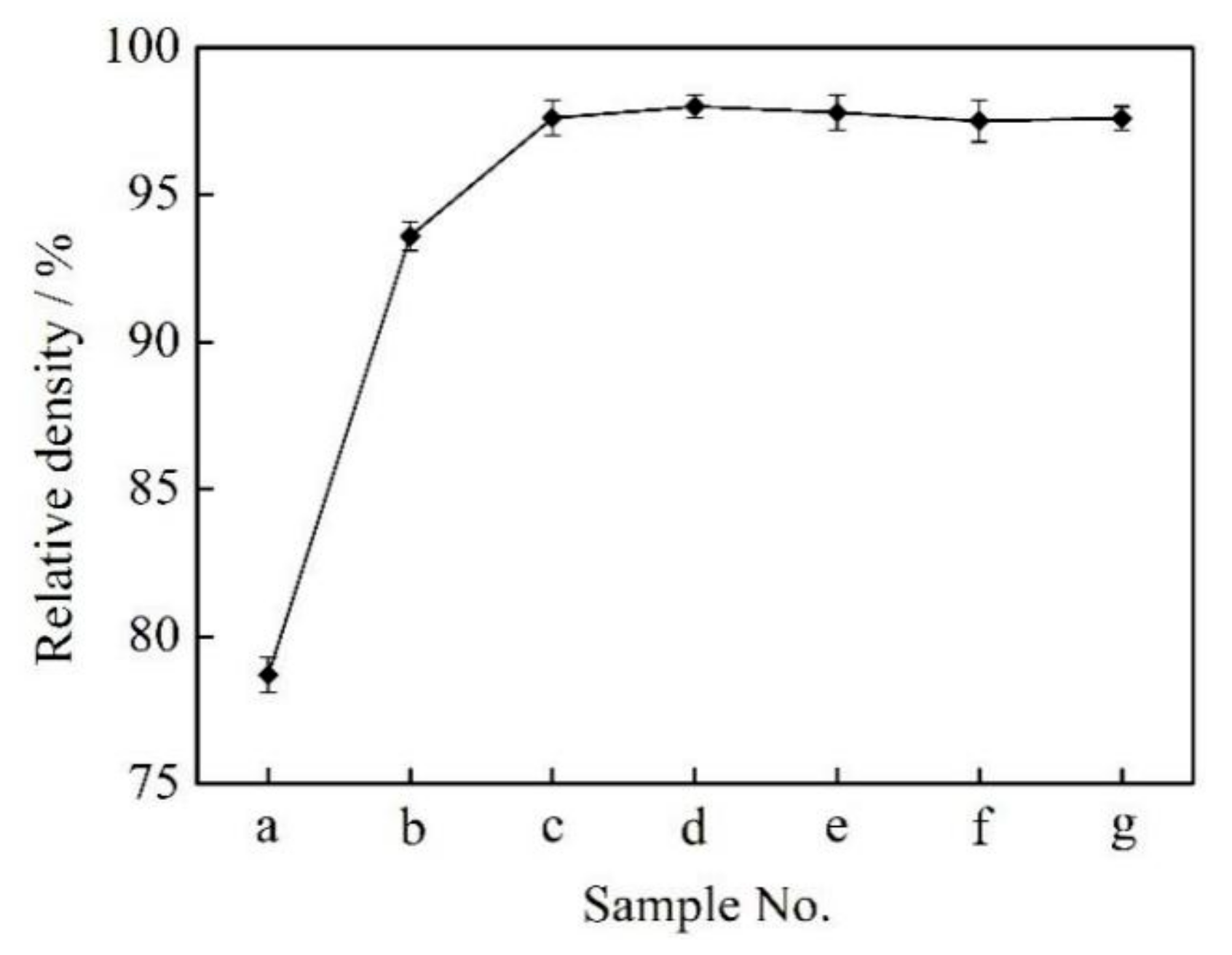
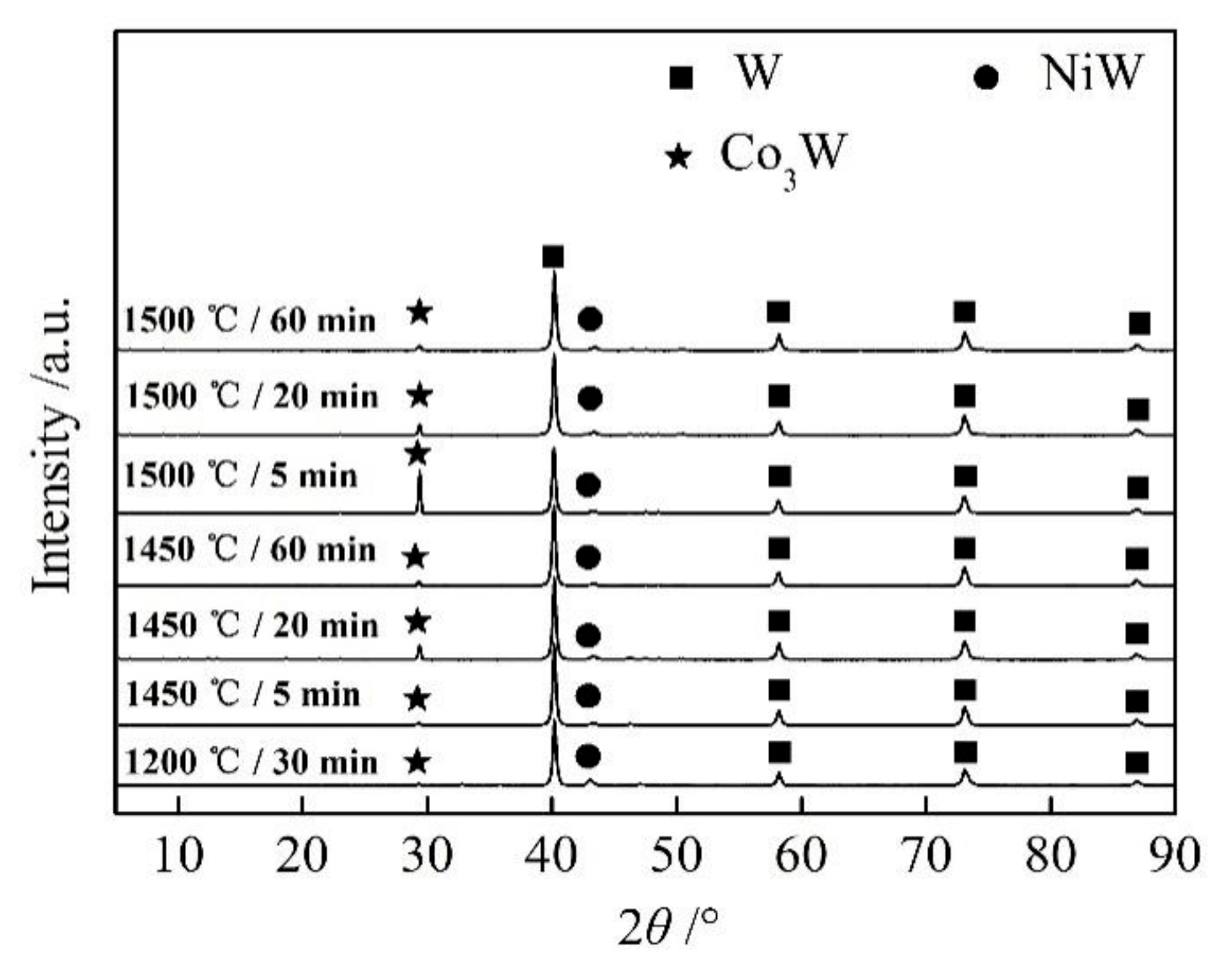
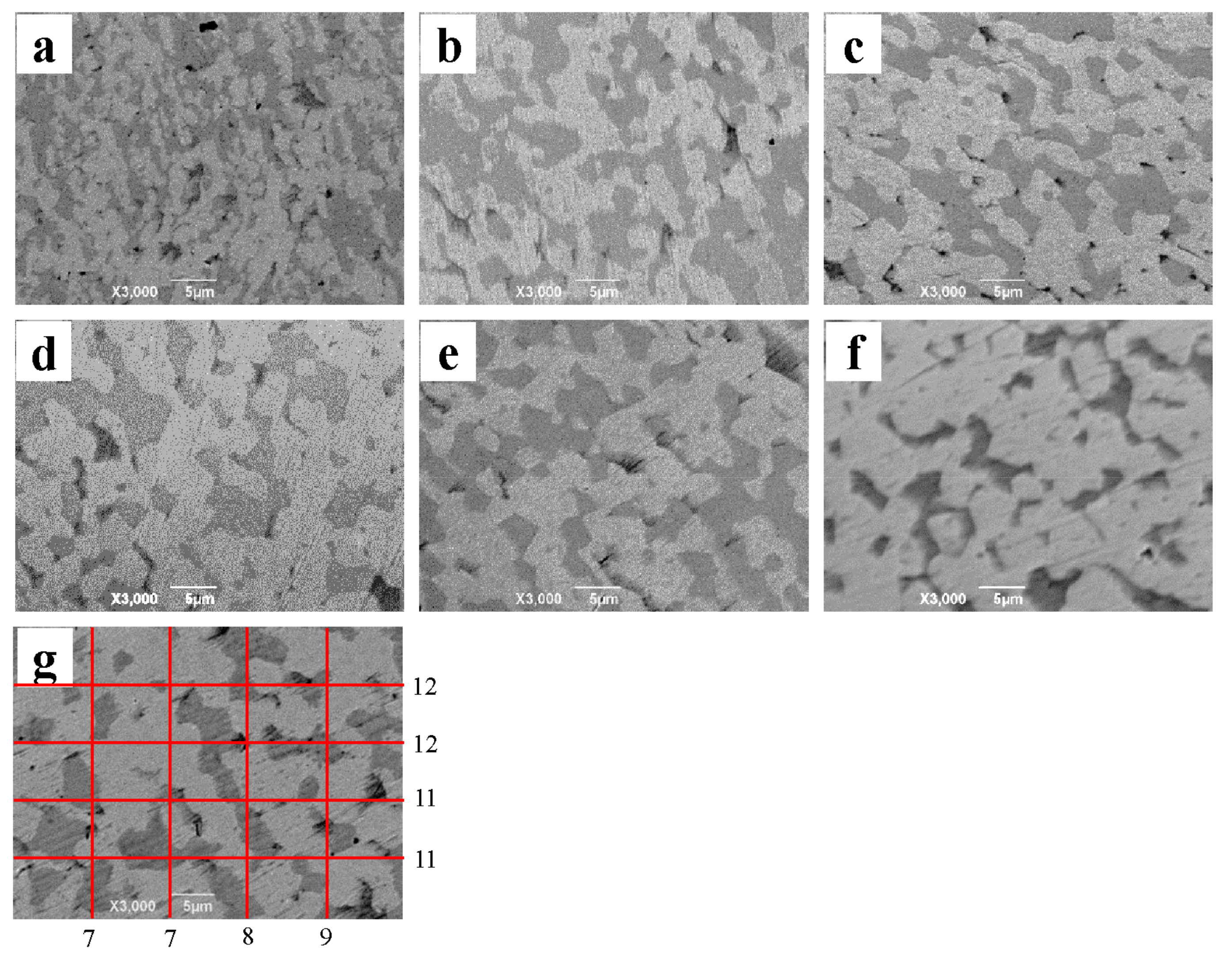
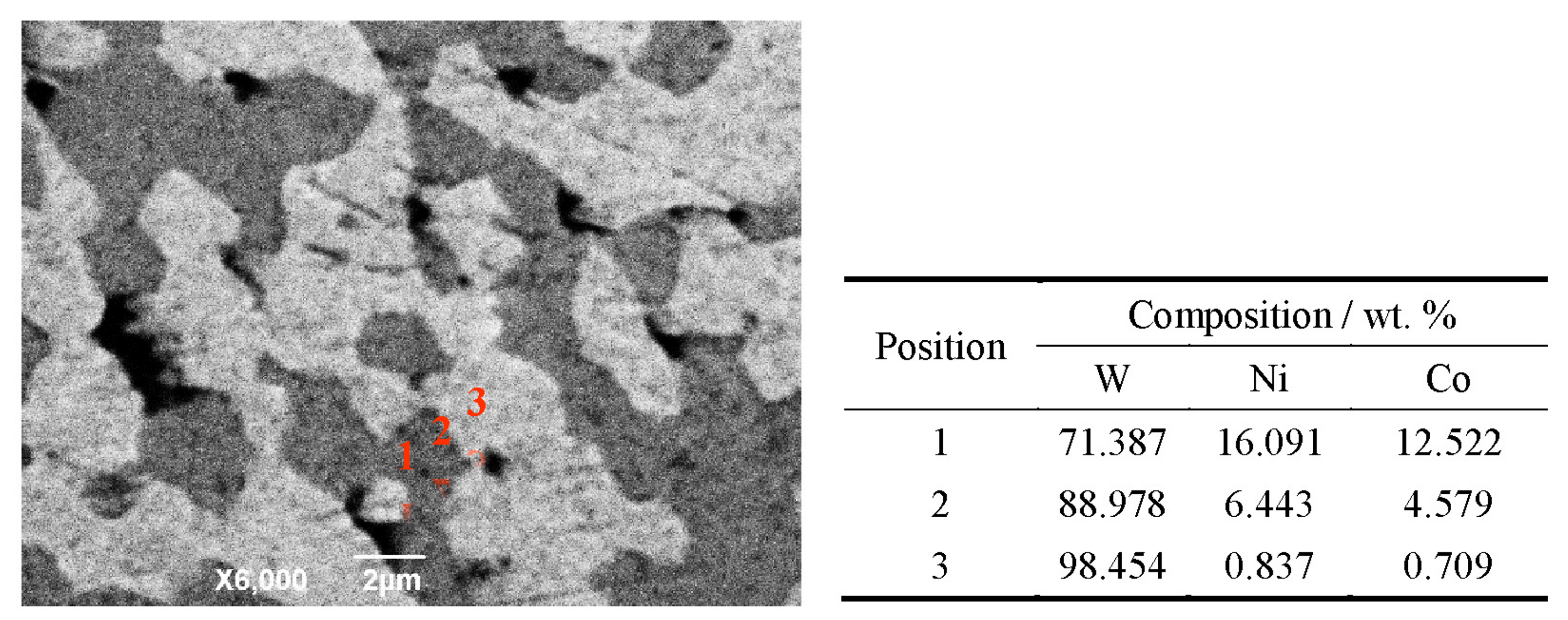
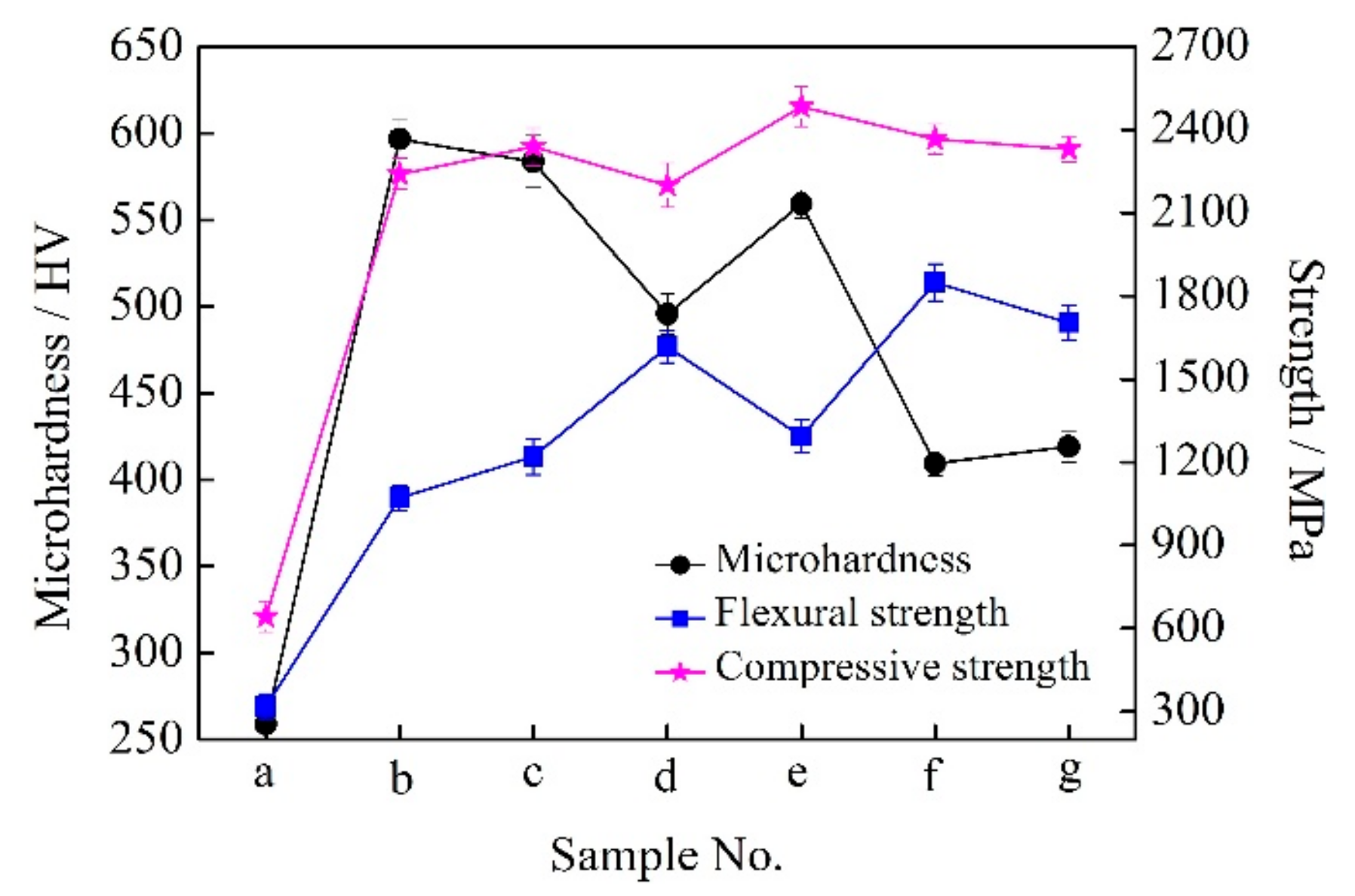
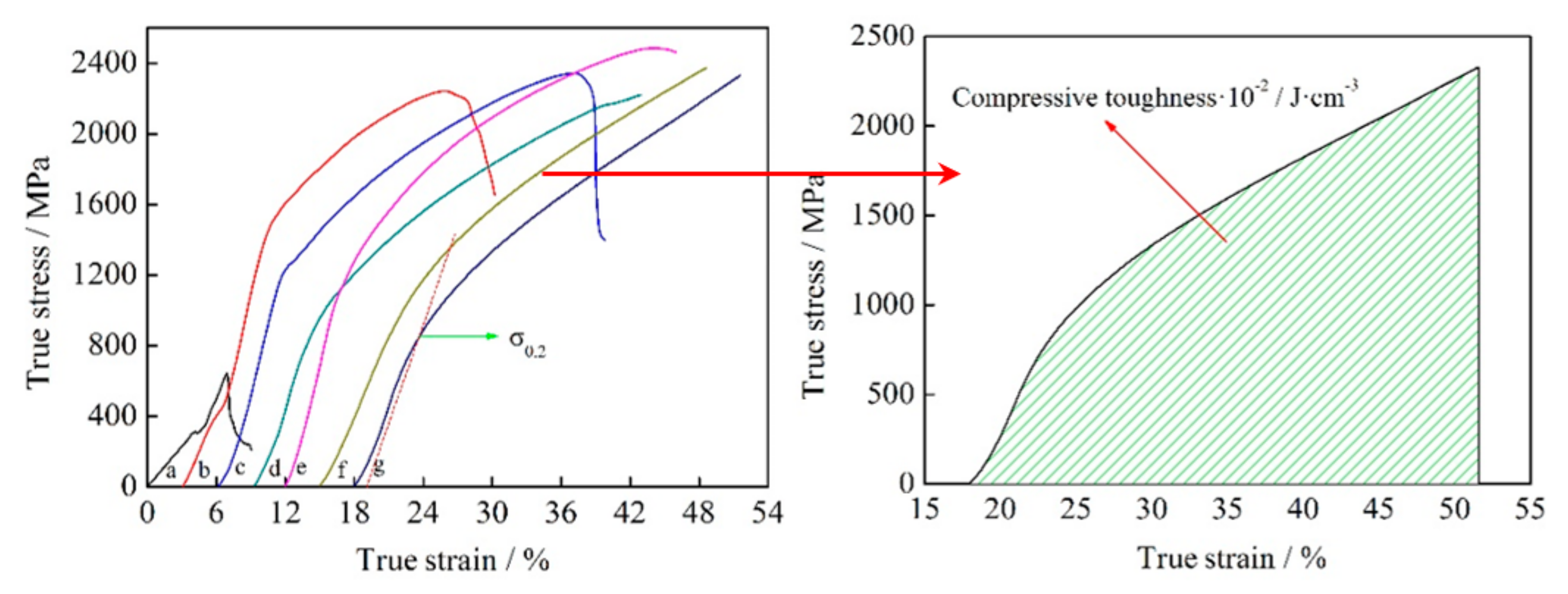
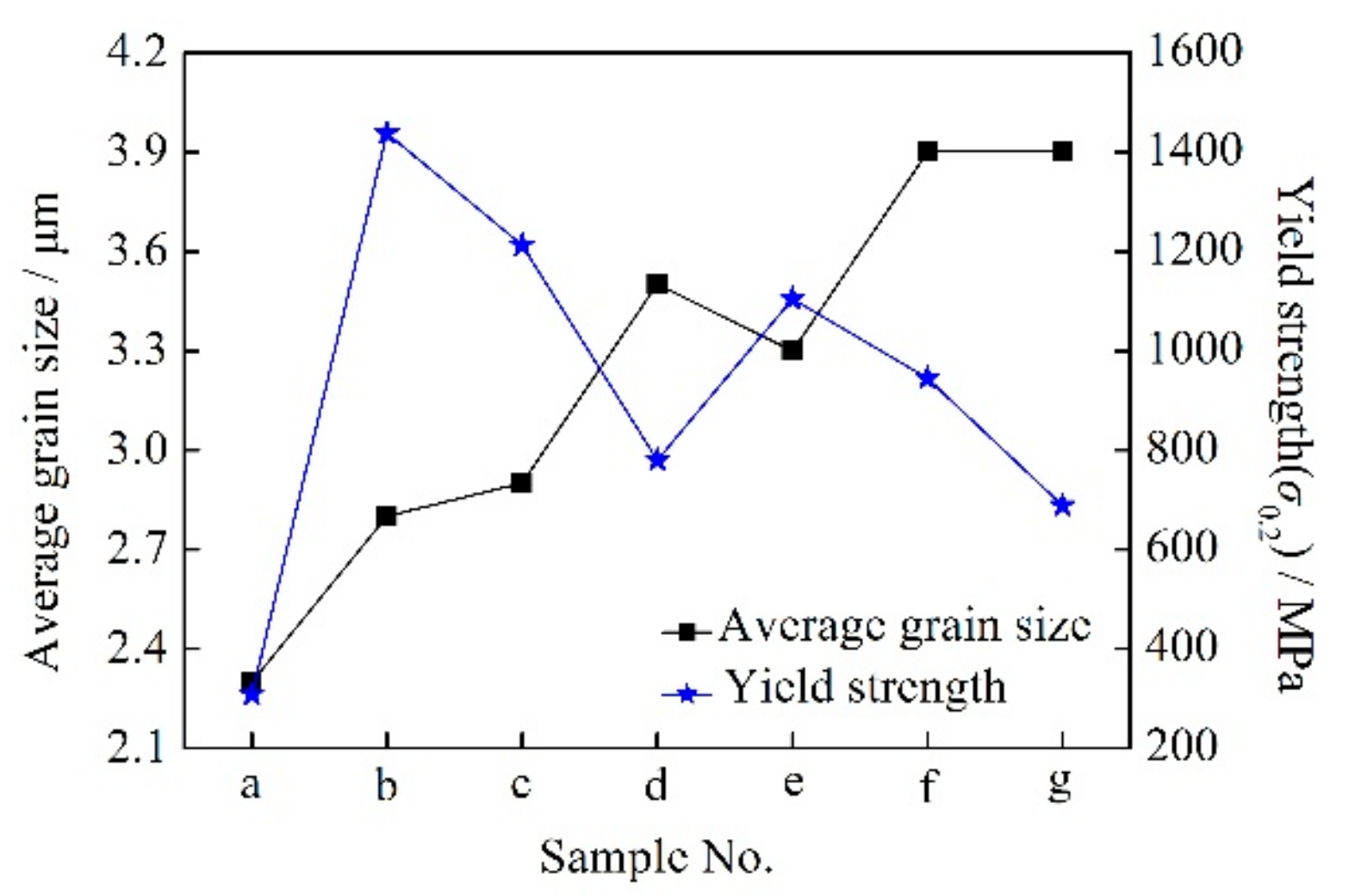
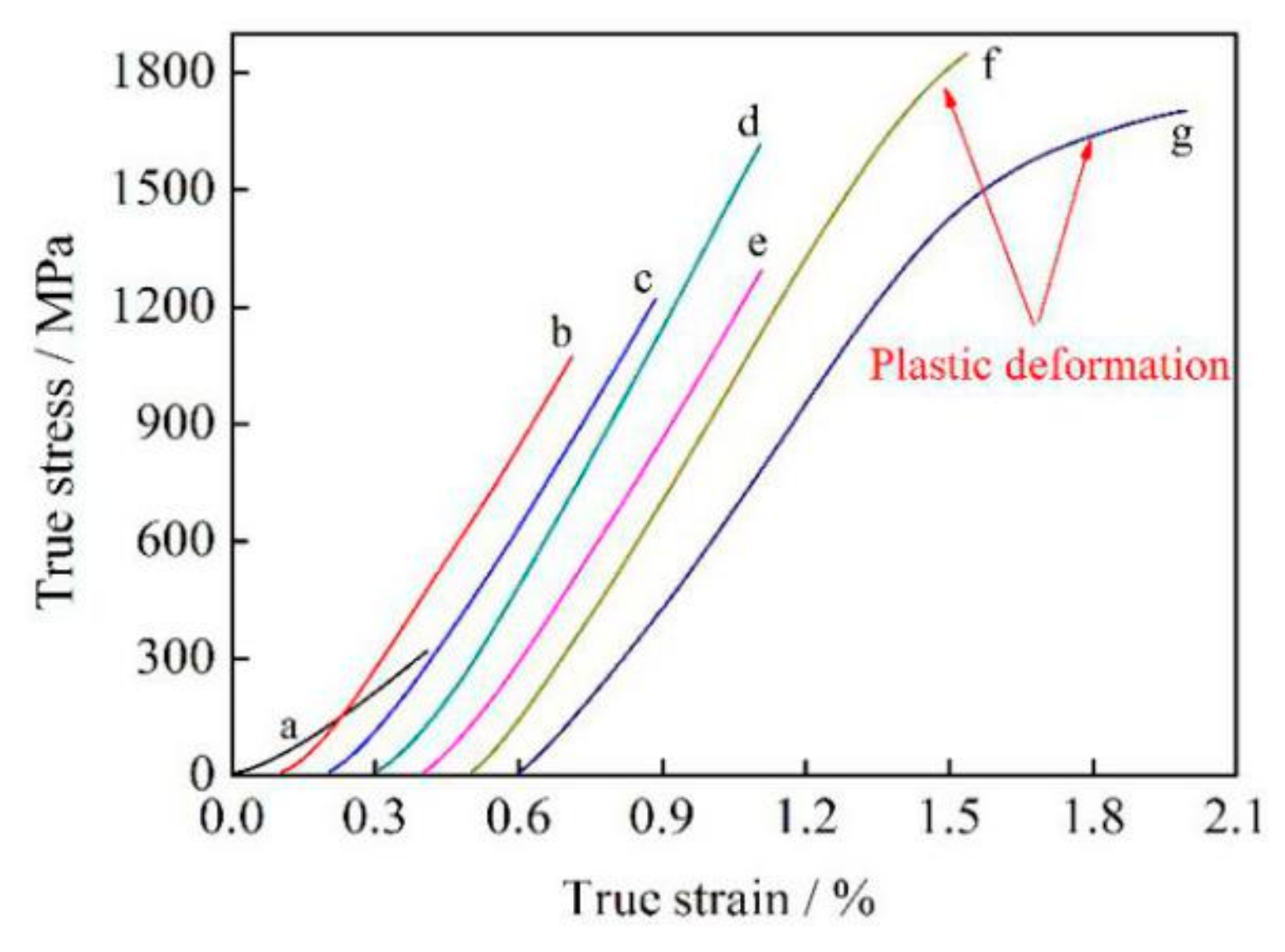

| Element | Mass Fraction (wt. %) | Average Size (μm) | Preparation Method |
|---|---|---|---|
| W | 90 | 3 | Reduction |
| Ni | 6 | 5 | Electrolysis |
| Co | 4 | 5 | Electrolysis |
| Sintering Process | Process No. and Sample No. | Temperature /°C | Dwelling Time /min | Cooling Way |
|---|---|---|---|---|
| Solid phase sintering | a | 1200 | 30 | Furnace |
| Two-step sintering (a+) | b | 1450 | 5 | Furnace |
| c | 1450 | 20 | Furnace | |
| d | 1450 | 60 | Furnace | |
| e | 1500 | 5 | Furnace | |
| f | 1500 | 20 | Furnace | |
| g | 1500 | 60 | Furnace |
| Sample No. | Volume Fraction of Phases/% | ||
|---|---|---|---|
| W | NiW | Co3W | |
| a | 94.69 | 4.58 | 0.73 |
| b | 97.72 | 1.15 | 1.13 |
| c | 93.51 | 1.19 | 5.30 |
| d | 97.09 | 1.28 | 1.63 |
| e | 83.77 | 1.63 | 14.60 |
| f | 95.80 | 1.35 | 2.85 |
| g | 96.66 | 1.89 | 1.45 |
| Sample No. | HV | σbb/MPa | σb/MPa | σ0.2/MPa | At/J·cm−3 |
|---|---|---|---|---|---|
| a | 258.63 | 318.60 | 642.80 | 307.73 | 25.69 |
| b | 596.47 | 1072.20 | 2240.20 | 1437.40 | 434.90 |
| c | 583.60 | 1220.40 | 2338.40 | 1211.82 | 568.59 |
| d | 495.53 | 1616.70 | 2200.70 | 779.56 | 509.97 |
| e | 559.13 | 1293.70 | 2483.50 | 1104.58 | 624.72 |
| f | 409.23 | 1849.70 | 2366.70 | 944.66 | 509.73 |
| g | 419.20 | 1703.00 | 2330.10 | 687.85 | 494.51 |
© 2019 by the authors. Licensee MDPI, Basel, Switzerland. This article is an open access article distributed under the terms and conditions of the Creative Commons Attribution (CC BY) license (http://creativecommons.org/licenses/by/4.0/).
Share and Cite
Dong, H.; Li, P.; Ai, T.; Li, W. Mechanical Properties and Microstructure of W-6Ni-4Co Alloy by a Two-Step Sintering Process. Metals 2019, 9, 680. https://doi.org/10.3390/met9060680
Dong H, Li P, Ai T, Li W. Mechanical Properties and Microstructure of W-6Ni-4Co Alloy by a Two-Step Sintering Process. Metals. 2019; 9(6):680. https://doi.org/10.3390/met9060680
Chicago/Turabian StyleDong, Hongfeng, Peiyou Li, Taotao Ai, and Wenhu Li. 2019. "Mechanical Properties and Microstructure of W-6Ni-4Co Alloy by a Two-Step Sintering Process" Metals 9, no. 6: 680. https://doi.org/10.3390/met9060680
APA StyleDong, H., Li, P., Ai, T., & Li, W. (2019). Mechanical Properties and Microstructure of W-6Ni-4Co Alloy by a Two-Step Sintering Process. Metals, 9(6), 680. https://doi.org/10.3390/met9060680





